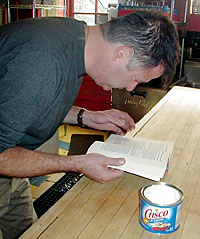Last week’s Department of Health proposed ban on trans-fats in restaurants city-wide caused such a firestorm that I immediately called Brooklyn’s great chef Alan Harding to find out what it would mean for his customers.
The ban was such big news that I expected to find Harding — the genius behind such Smith Street institutions as Patois and Pacifico — already in the kitchen, feverishly devising new recipes.
Instead, I woke him up.
“Trans-fats?” Harding grumbled into the phone, his voice sounding like an unshaven face. “I never use them. At least, I think I never use them. What are they again?”
Clearly, he hadn’t heard the news.
Clearly, he didn’t care.
But a journalist of my food-consuming talents has to care. After all, I’ve been on the trans-fat case ever since scientists determined that these pernicious Franken-lipids — also known as “partially hydrogenated” oils — clog your arteries, lower your “good” cholesterol, and lack “good” fats like Omega-3 fatty acids.
Foods made with trans-fats also have rock-like shelf life. But trans-fats were actually invented 100 years ago as a substitute for the more expensive animal-fat candles. They worked so well as cooking grease that Proctor and Gamble called it Crisco and sold it. As food.
Now, trans-fats are the call girls of the food supply: they’re cheap, they’re easy, they’ll do whatever you want, and they’ll leave you feeling lousy afterwards.
They’re so omnipresent in the American diet that even the government eventually noticed them.
The Bloomberg Administration’s proposed trans-fat ban brought about the predictable hue and cry from the live-and-let die crowd, which dubbed the mayor a “nanny” because he’s always trying to prevent us from harming ourselves.
Kuntzman’s Seduction Chicken
Adapted by Chef Alan Harding
- 2 boneless chicken breasts
- Salt and pepper
- 1/2 cup Wondra flour
- 1 cup shallots, sliced thinly
- 2 tbls butter (or Crisco)
- 1 cup sherry
- 1/2 cup heavy cream
- 1/4 cup Dijon mustard
- Thyme to taste
Sprinkle salt, pepper and Wondra flour on chicken. Heat butter or Crisco in a saute pan until warm, but not smoking. Sear chicken on both sides, cooking about five minutes per side. Remove chicken and add shallots to pan. Cook until softened, about three minutes. Add sherry and ignite impressively. Do not allow the sherry to burn out completely until your guest sees what a fancy chef you are. Reduce heat and add cream and mustard. Return chicken to pan and baste with the mustard-sherry sauce. Place chicken on plate, spoon sauce over it, and sprinkle some thyme over it, which will also impress your guest. Eat, enjoy and, perhaps, get lucky.
But the difference between, say, the mayor’s smoking crackdown and the trans-fat ban is simple: People who smoke not only do so by choice, but know what they’re doing to their bodies (it’s written right there on the package!).
But no one, not even Marty Markowitz on a bender, goes into McDonald’s and says, “Can I get those fries with extra trans-fat?” In fact, most people don’t even know what a trans-fat is (see molecule, below), let alone the foods in which they’re lurking.
That’s where Harding came in. After rousing himself from his stupor, he told me to meet him at Patois, where we’d do some cooking.
“Bring the Crisco,” he said, sounding a bit too much like Marlon Brando in “Last Tango in Paris.”
Once ensconced at Patois, I sliced potatoes, while Harding gave me a primer on kitchen oils.
“We use canola oil in the deep-fryer, but not the partially hydrogenated kind,” he said. “It lasts about five days. But the partially hydrogenated stuff, that’s the Cadillac of deep-fry oils. They last much longer before breaking down.”
Harding fired up the deep fryer and I melted some Crisco in a pan. When both were ready, we dropped the potato slices into the hot oil — and were stunned to find that the potato chips made in the canola oil and the Crisco were identical. If anything, the Crisco chips were crispier.
“Just like those old Southern ladies always told me: Always fry in Crisco,” Harding said.
I wasn’t convinced, though, and asked Harding to bump it up a notch (as Emeril might say). He pulled out two chicken breasts and pan-seared one in butter and oil — in the classic French tradition — and the other in Crisco.
I chopped shallots.
As the chicken cooked, Harding readied some wine, heavy cream and mustard, and I realized that he was cooking his own version of a legendary dish known as “Kuntzman’s Seduction Chicken,” a main course that dates back to my single days, when I served it whenever I wanted to impress a woman. For years, I had sporadic success with the dish — although all that butter and cream typically left my dates feeling bloated and in need of a nap (a chaste nap, to boot).
Like so many things, if I knew then what I know now, I might have done much better: The “Seduction Chicken” cooked in the Crisco actually turned out lighter and more flavorful than the one Harding made in butter.
“This is going to sound heretical for a classically trained chef, but the butter sauce is so heavy that I can’t taste the chicken, wine or the shallots,” Harding said. “The Crisco sauce is clean and lets all the food flavors come through.”
So you heard him, Nanny Bloomberg: Please don’t take away our Franken-fats!























